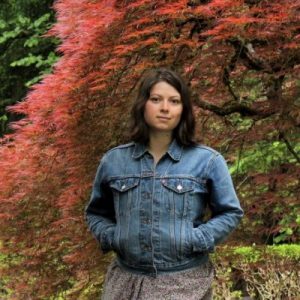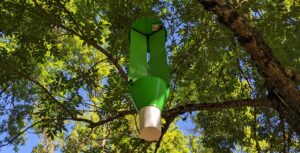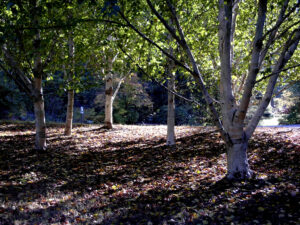Volunteering at Hoyt Arboretum
It takes a village to raise an arboretum. 200 acres, 12 miles of trails, more than 6,000 trees, and a changing climate thrown into the mix is a lot to contend with! The dedicated staff that steward Hoyt Arboretum are skilled and knowledgeable, but we could not provide the required level of care without our strong volunteer base. Each volunteer has a unique background and skill set to contribute, and can select any number of projects that fit their personal goals.
Applying Unique Experiences
For born-and-raised Oregonian, Marissa Shumaker, that was first with Tuesday Crew, and more recently, the Early Detection of Invasive Pests Community Science project, protecting our beautiful ash, olive, and fringetrees from the threat of invasive emerald ash borers (EAB).


A scientist by trade, Marissa has a Bachelors in Biology from the University of Portland. After graduation she was faced with a decision many fresh bio-grad job-seekers must make: field or lab work. She chose the latter for an opportunity to delve into the world of biotech, microbes, and bacteria. While she loves what she does, she admitted to often wishing for an escape to the outdoors while stuck in a lab or office. She hit a turning point in 2019 and decided to take a year off from work to travel and explore.
But, upon returning in 2020, she found the job market in a different state from when she left. It is then that she began volunteering at Hoyt Arboretum with the tight-knit Tuesday Crew.
Of this experience, she said “I look back on that time of uncertainty, actually, as a period of profound grounding. I was able to spend my free time outdoors, with a community, and really felt like I was making a difference.”
On Tuesday Crew, Marissa was part of a group that worked to clear a strip of free parking on Fairview outside the Visitor Center. “Now, every time I park there when I come to the Arboretum I remember that experience and feel proud of what we accomplished.”
Tuesday Crew to Invasive Pests
While volunteering on the crew, Marissa was inspired by the work of our Plant Taxonomist Mandy Tu, and Curator Martin Nicholson. She soaked up every bit of botanical knowledge she could from Mandy, and from Martin, she was instilled with the principle that we need to “protect what we have, and plan ahead” –in reference to the tree collection and climate change.
A highly-trained Biotechnologist with Project Management experience, it’s no wonder Marissa wasn’t unemployed for long, and when she returned to work, her time on Tuesday crew came to an end. With her passion for botany and conservation in the face of climate change irrevocably stoked, she was looking for a way to stay connected at the Arboretum.
In times like these, there’s only one person to turn to: Becky Schreiber. Arboretum regulars, friends, and volunteers all know our Deputy Director to be the holder of all answers, and for Marissa, this time it was Community Science! Becky recommended she utilize her scientific expertise as part of the Early Detection of Invasive Pests project.
“This was the perfect volunteer option for me. I was able to work independently, on my own time, AND have an excuse to make regular trips out to the Arboretum-my project kit always ready in my car.”
Marissa was responsible for monitoring a trap for emerald ash borers in a green ash tree on Overlook Trail. As any good scientist would, she provided a detailed and nuanced description of the methodology for checking the trap: emptying the white collection cup of the trap, filtering the antifreeze from the invertebrate specimens through a coffee filter into a mason jar, examining the insects while looking for the tell tale characteristics of EABs, collecting anything of interest in her specimen container, reporting her findings, and resetting the trap.


When asked what she found in the trap she stated “mostly yellow jackets, some moths, and other various beetles, but no emerald ash borers, or any signs that would make me suspicious of their presence at that site.”
Volunteers on this project are also trained to recognize visual signs of damage on host trees that could point to the presence of a pest. For emerald ash borers, signs include S-shaped borer galleries in the wood underneath peeling bark, D-shaped exit holes of adults leaving the tree, and extra woodpecker damage (from feasting on a big population of EAB larvae).
Loving Hoyt Arboretum
Throughout the season, Marissa would come out to the Arboretum once a week to check the trap, but she said that only took 10-15 minutes. She didn’t mind though, relishing the opportunity to have a walk and enjoy the park.


Favorite trail: Redwood- she loves the peace and beauty of the Redwood Deck.
Favorite tree: birch- she has childhood memories of collecting the papery bark for writing secret messages.
The Future Looks Bright!
Wrapping up the season, Marissa is beginning a new transition, with a plan to move to Stanford to work in a lab studying microbes that break down plastics (AMAZING!). She eventually has the goal of transitioning from the biotech industry to academics. With a somewhat recently discovered interest in plant biology, she has plans to pursue a PhD in the field.
Thank You!
We’d like to thank Marissa for sharing her expertise and working hard to make the Arboretum a better place. Good luck in everything you do, and make sure to visit us lots too!
Read some blog posts contributed by Marissa for the Arboretum:
Familiar Feathers, or 4 Bird Species You Didn’t Know You Knew
